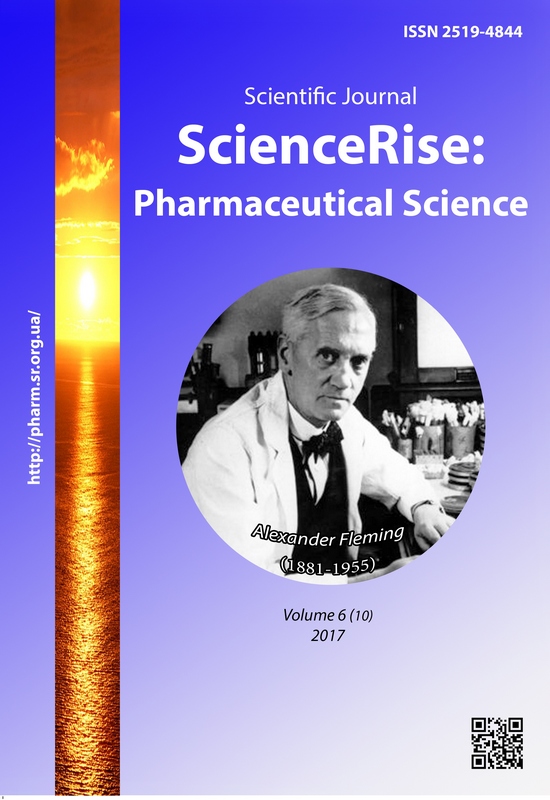Cycloalkanecarbaldehydes in synthesis of novel 1,2-benzoxathiin-4(3H)-on 2,2-dioxide derivatives and study of the antimicrobial activity of synthesized compounds
DOI:
https://doi.org/10.15587/2519-4852.2017.119279Keywords:
1, 2-benzoxathiin-4(3H)-one 2, 2-dioxide, 2-amino-4H-pyran, multicomponent reaction, cycloalkanecarbaldehyde, ammonium salt, antimicrobial activityAbstract
Purpose: This paper is dedicated to the investigation of cycloalkanecarbaldehydes, 1,2-benzoxathiin-4(3H)-on 2,2-dioxide and active methylene nitriles interaction and to studying antimicrobial properties of the obtained compounds.
Methods: As initial products were used cycloalkanecarbaldehydes 1,2-benzoxathiin-4(3H)-on 2,2-dioxide and active methylene nitriles. During the course of the research were applied the methods of organic synthesis. The structures of the obtained compounds were confirmed by elemental analysis and 1H NMR spectroscopy. The antimicrobial activity was measured with the agar “well” diffusion method.
Results: New 2-amino-4H-pyrans were synthesized by three-component reaction of cycloalkanecarbaldehydes, 1,2-benzoxathiin-4(3H)-on 2,2-dioxide and malononitrile. The replacement of the latter with ethylcyanoacetate in the case of cyclohexanecarbaldehyde led to the isolation of triethylammonium3-[(4-hydroxy-2,2-dioxido-2,1-benzoxathiin-3-yl)(cyclohexyl)methyl]-2,1-benzoxathiin-5-olat 2,2-dioxide. Based on this result and considering originality of such ammonium salts the latter were purposefully synthesized with two-component approach using a range of secondary and tertiary amines. The synthesized compounds demonstrated higher antimicrobial activity than the reference drugs against the gram-positive strains.
Conclusions: The current research showed the prospective pathway for the expanding of the existing 2-amino-4H-pyrans diversity by utilizing in their synthesis such enolnucleophile and carbonyl compounds as 1,2-benzoxathiin-4(3H)-one 2,2-dioxide and cycloalkanecarbaldehydes respectively. The revealed antimicrobial activity of the obtained compounds against gram-positive microorganisms gives the opportunity for further investigations of narrow spectrum antibiotics among this group
References
- CAS REGISTRY 100 Millionth Fun Facts (2015). American Chemical Society. Available at: https://www.cas.org/content/chemical-substances/cas-registry-100-millionth-fun-facts
- Mungra, D. C., Patel, M. P., Rajani, D. P., Patel, R. G. (2011). Synthesis and identification of β-aryloxyquinolines and their pyrano[3,2-c]chromene derivatives as a new class of antimicrobial and antituberculosis agents. European Journal of Medicinal Chemistry, 46 (9), 4192–4200. doi: 10.1016/j.ejmech.2011.06.022
- Amr, A.-G. E., Mohamed, A. M., Mohamed, S. F., Abdel-Hafez, N. A., Hammam, A. E.-F. G. (2006). Anticancer activities of some newly synthesized pyridine, pyrane, and pyrimidine derivatives. Bioorganic & Medicinal Chemistry, 14 (16), 5481–5488. doi: 10.1016/j.bmc.2006.04.045
- Litvinov, Y. M., Shestopalov, A. M.; Katritzky, A. (Ed.) (2011). Synthesis, Structure, Chemical Reactivity, and Practical Significance of 2-Amino-4H-pyrans. Advances in Heterocyclic Chemistry. Vol. 103. Boston: Academic Press, 175–273. doi: 10.1016/b978-0-12-386011-8.00003-4
- Lega, D. A., Gorobets, N. Y., Chernykh, V. P., Shishkina, S. V., Shemchuk, L. A. (2016). Peculiarities of 2-amino-3-R-4-aryl-4H-pyranes multicomponent synthesis derived from 1H-2,1-benzothiazin-4(3H)-one 2,2-dioxide. RSC Advances, 6 (19), 16087–16099. doi: 10.1039/c5ra24566d
- Lega, D. A., Chernykh, V. P., Zaprutko, L., Gzella, A. K., Shemchuk, L. A. (2017). Synthesis of 1-ethyl-1H-2,1-benzothiazine 2,2-dioxide derivatives using cycloalkanecarbaldehydes and evaluation of their antimicrobial activity. Chemistry of Heterocyclic Compounds, 53 (2), 219–229. doi: 10.1007/s10593-017-2043-7
- Filimonova, N. I., Lega, D. O., Zupanets, I. A. et. al. (2016). Antimicrobial, anti-inflammatory and analgesic activities of 2-amino-6-ethyl-4,6-dihydropyrano[3,2-c][2,1]benzothiazine 5,5-dioxides and triethylammonium 3-[1-(4-hydroxy-1-ethyl-2,2-dioxido-1H-2,1-benzothiazin-3-yl)-3-(het)arylmethyl]-1-ethyl-1H-2,1-benzothiazin-4-olat 2,2-dioxides. News of Pharmacy, 3 (87), 61–69.
- Coyle, M. B. (2005). Manual of Antimicrobial Susceptibility Testing. American Society for Microbiology. Washington: American Society for Microbiology, 236.
- Performance Standards for Antimicrobial Susceptibility Testing; Twenty-Second Informational Supplement. Document M100-S22 (2012). Wayne: CLSI, 32 (3), 188.
- McFarland, J. (1907). Nephelometer: An Instrument for Estimating the Number of Bacteria in Suspensions Used for Calculating the Opsonic Index and for Vaccines. Journal of the American Medical Association, 49 (14), 1176–1178. doi: 10.1001/jama.1907.25320140022001f
Downloads
Published
How to Cite
Issue
Section
License
Copyright (c) 2018 Galyna Grygoriv, Dmytry Lega, Valentine Chernykh, Tetyana Osolodchenko, Leonid Shemchuk

This work is licensed under a Creative Commons Attribution 4.0 International License.
Our journal abides by the Creative Commons CC BY copyright rights and permissions for open access journals.








